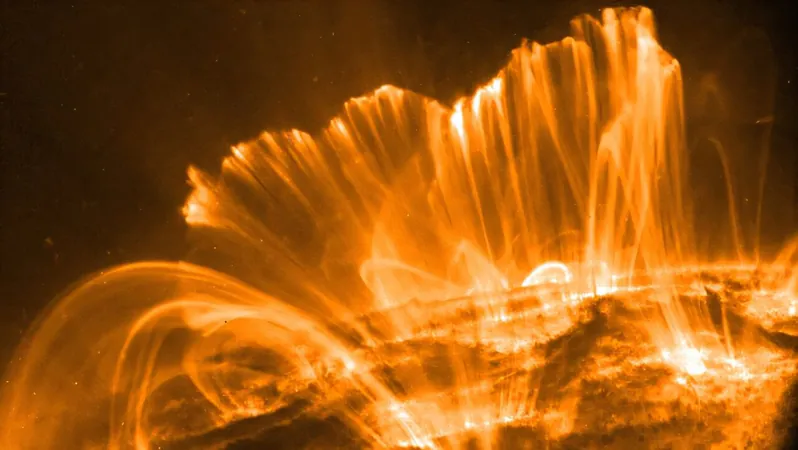
Unveiling Solar Secrets: How AI is Transforming Our Understanding of the Sun
2024-11-25
Author: Olivia
Recent groundbreaking research from the University of Hawaiʻi's Institute for Astronomy (IfA) is set to change the way we observe and understand solar phenomena. The innovative study, part of a larger initiative known as the "SPIn4D" project, merges cutting-edge techniques in solar astronomy with state-of-the-art computer science, focusing on data from the impressive Haleakalā summit telescope in Maui, which boasts the title of the world's most powerful solar observatory.
The research has been published in The Astrophysical Journal and showcases how the development of advanced deep learning algorithms can process massive quantities of data collected from the U.S. National Science Foundation's (NSF) Daniel K. Inouye Solar Telescope with unprecedented speed and precision. The primary objective? To harness the telescope's capabilities and delve deeper into the mysteries of the solar atmosphere, potentially leading to significant advancements in solar data analysis and our understanding of solar storms.
According to Kai Yang, an IfA postdoctoral researcher leading the project, “Large solar storms can create mesmerizing auroras, but they also pose substantial risks to satellites, radio communication systems, and electrical grids. Understanding their origins in the solar atmosphere is crucial.” Yang emphasizes the power of their simulations, stating that combining them with machine learning techniques allows for near real-time exploration of the sun's complex three-dimensional structure.
The Inouye Solar Telescope, located at the 10,000-foot peak of Haleakalā—an area famously referred to as "the house of the sun"—is engineered to analyze the sun's magnetic fields using polarized light. The SPIn4D project capitalizes on the exclusive data that the telescope's unique instrumentation collects, elevating research capabilities to new heights.
Revolutionary Research and AI Integration
The collaborative team, consisting of experts from NSO and the High Altitude Observatory (HAO), employs deep neural networks to provide swift estimates of solar photospheric properties based on high-resolution imagery captured by the Inouye Solar Telescope. This promising methodology could enhance efficiency in processing the immense data volumes generated daily by the telescope—sometimes exceeding tens of terabytes.
Machine learning, as co-author Peter Sadowski (an associate professor at the UH Mānoa information and computer sciences department) notes, can deliver rapid approximations of complex computations. “With this model in place, astronomers can visualize the solar atmosphere in real time, cutting down the waiting period from hours to mere moments for accurate data interpretation,” he explains.
Simulating the Sun's Dynamics
To train their sophisticated AI models, the research team has amassed an extensive dataset of simulated solar observations. Utilizing the NSF's Cheyenne supercomputer, they dedicated over 10 million CPU hours to generate 120 terabytes of high-resolution data that faithfully replicate the Inouye Solar Telescope's observations.
In a move to foster community engagement and further research, the team has released a 13-terabyte subset of their dataset to the public, complete with a comprehensive tutorial. They also have plans to make their fully trained deep learning models accessible as a community tool, paving the way for researchers worldwide to analyze and interpret the Inouye Solar Telescope's observations more effectively.
As this research unfolds, it not only underscores the remarkable synergy between astronomy and artificial intelligence but also opens doors to new insights about our solar system that could have far-reaching consequences for technology and safety on Earth. Get ready to dive into an era where we can observe the sun like never before!









 Brasil (PT)
Brasil (PT)
 Canada (EN)
Canada (EN)
 Chile (ES)
Chile (ES)
 España (ES)
España (ES)
 France (FR)
France (FR)
 Hong Kong (EN)
Hong Kong (EN)
 Italia (IT)
Italia (IT)
 日本 (JA)
日本 (JA)
 Magyarország (HU)
Magyarország (HU)
 Norge (NO)
Norge (NO)
 Polska (PL)
Polska (PL)
 Schweiz (DE)
Schweiz (DE)
 Singapore (EN)
Singapore (EN)
 Sverige (SV)
Sverige (SV)
 Suomi (FI)
Suomi (FI)
 Türkiye (TR)
Türkiye (TR)